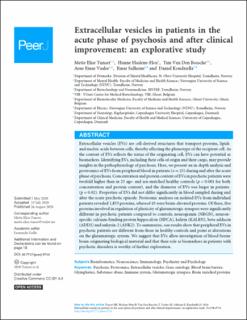Extracellular vesicles in patients in the acute phase of psychosis and after clinical improvement: an explorative study
| dc.contributor.author | Tunset, Mette Elise | |
| dc.contributor.author | Haslene-Hox, Hanne | |
| dc.contributor.author | Bossche, Tim Van Den | |
| dc.contributor.author | Vaaler, Arne | |
| dc.contributor.author | Sulheim, Einar | |
| dc.contributor.author | Kondziella, Daniel | |
| dc.date.accessioned | 2022-06-01T11:31:38Z | |
| dc.date.available | 2022-06-01T11:31:38Z | |
| dc.date.created | 2021-01-05T16:13:46Z | |
| dc.date.issued | 2020 | |
| dc.identifier.citation | PeerJ. 2020, (8), 1-29. | en_US |
| dc.identifier.issn | 2167-8359 | |
| dc.identifier.uri | https://hdl.handle.net/11250/2997225 | |
| dc.description.abstract | Extracellular vesicles (EVs) are cell-derived structures that transport proteins, lipids and nucleic acids between cells, thereby affecting the phenotype of the recipient cell. As the content of EVs reflects the status of the originating cell, EVs can have potential as biomarkers. Identifying EVs, including their cells of origin and their cargo, may provide insights in the pathophysiology of psychosis. Here, we present an in-depth analysis and proteomics of EVs from peripheral blood in patients (n = 25) during and after the acute phase of psychosis. Concentration and protein content of EVs in psychotic patients were twofold higher than in 25 age- and sex-matched healthy controls (p < 0.001 for both concentration and protein content), and the diameter of EVs was larger in patients (p = 0.02). Properties of EVs did not differ significantly in blood sampled during and after the acute psychotic episode. Proteomic analyses on isolated EVs from individual patients revealed 1,853 proteins, whereof 45 were brain-elevated proteins. Of these, five proteins involved in regulation of plasticity of glutamatergic synapses were significantly different in psychotic patients compared to controls; neurogranin (NRGN), neuron-specific calcium-binding protein hippocalcin (HPCA), kalirin (KALRN), beta-adducin (ADD2) and ankyrin-2 (ANK2). To summarize, our results show that peripheral EVs in psychotic patients are different from those in healthy controls and point at alterations on the glutamatergic system. We suggest that EVs allow investigation of blood-borne brain-originating biological material and that their role as biomarkers in patients with psychotic disorders is worthy of further exploration. | en_US |
| dc.language.iso | eng | en_US |
| dc.publisher | PeerJ | en_US |
| dc.rights | Navngivelse 4.0 Internasjonal | * |
| dc.rights.uri | http://creativecommons.org/licenses/by/4.0/deed.no | * |
| dc.subject | Brain enriched proteins | en_US |
| dc.subject | Glutamatergic synapses | en_US |
| dc.subject | Immune system | en_US |
| dc.subject | Substance abuse | en_US |
| dc.subject | Glymphatics | en_US |
| dc.subject | Blood brain barrier | en_US |
| dc.subject | Gene ontology | en_US |
| dc.subject | Extracellular vesicles | en_US |
| dc.subject | Proteomics | en_US |
| dc.subject | Psychosis | en_US |
| dc.title | Extracellular vesicles in patients in the acute phase of psychosis and after clinical improvement: an explorative study | en_US |
| dc.type | Peer reviewed | en_US |
| dc.type | Journal article | en_US |
| dc.description.version | publishedVersion | en_US |
| dc.rights.holder | Copyright 2020 Tunset et al. | en_US |
| dc.source.pagenumber | 29 | en_US |
| dc.source.volume | 8 | en_US |
| dc.source.journal | PeerJ | en_US |
| dc.identifier.doi | 10.7717/peerj.9714 | |
| dc.identifier.cristin | 1865873 | |
| dc.source.articlenumber | e9714 | en_US |
| cristin.ispublished | true | |
| cristin.fulltext | original | |
| cristin.qualitycode | 1 |
Tilhørende fil(er)
Denne innførselen finnes i følgende samling(er)
-
Publikasjoner fra CRIStin - SINTEF AS [5654]
-
SINTEF Industri [1534]

